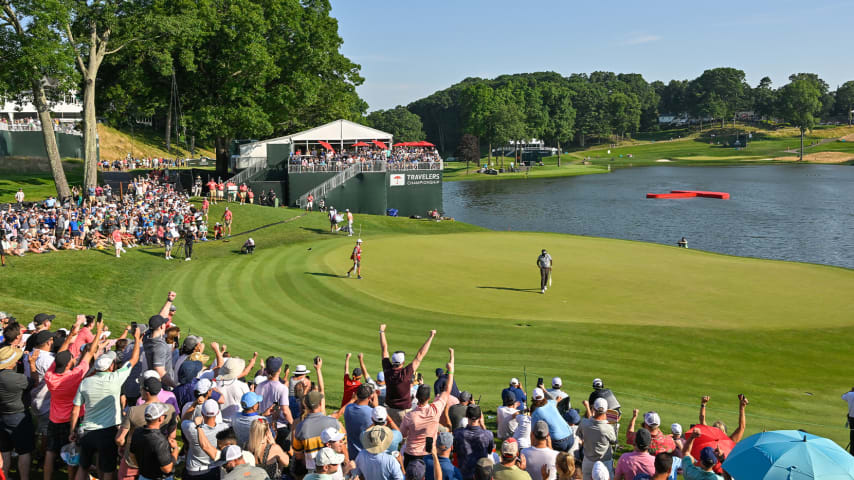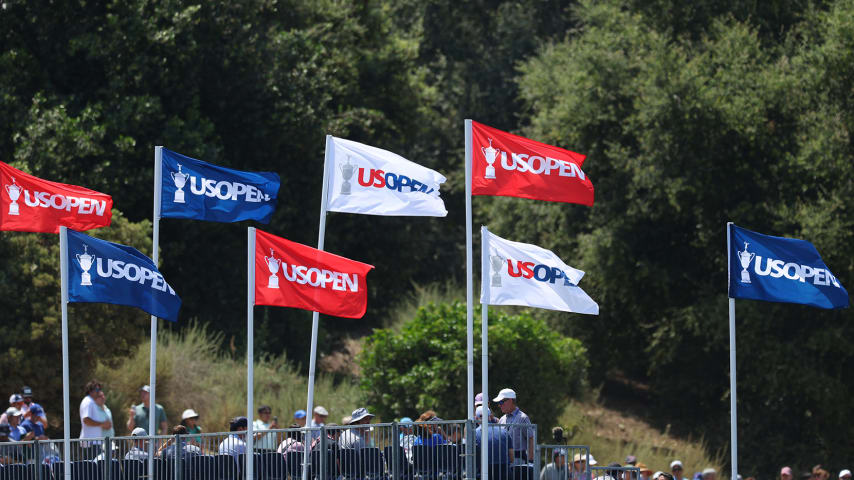Five things to know: TPC River Highlands
7 Min Read

Longtime host site of Travelers Championship, a Designated event in 2023
Written by Bradley S. Klein
Longtime host site of Travelers Championship, a Designated event in 2023
One of the PGA TOUR’s oldest and best attended events, the Travelers Championship has been contested at TPC River Highlands for three decades and counting.
New England’s long-running TOUR stop, which began life in 1952 as the Insurance City Open, benefits this year from its newfound status as a Designated event with a $20 million purse. A high-wattage field includes the world’s top five-ranked players in Scottie Scheffler, Jon Rahm, Rory McIlroy, Patrick Cantlay and Viktor Hovland.
Here are five things to know about TPC River Highlands as the world’s best descend upon Connecticut.
Nutmeg State unifier
Appropriately, TPC River Highlands is situated squarely in the center of Connecticut, a unifying course in a surprisingly divided state. At only 4,842 square miles, Connecticut is the country’s third smallest state, behind Delaware and Rhode Island. But with the Connecticut River splitting the state down the middle, there is very much a corresponding geographical orientation of sports loyalties: The Boston-area-based Red Sox, Patriots, Celtics and Bruins claim the eastern half of Connecticut, while the New York Yankees, Giants, Knicks and Rangers take precedence in the western half. (Word of the Mets, Jets, Nets, Devils or Islanders is scarcely to be found.)

Xander Schauffele’s Round 4 highlights from Travelers
Perhaps more divisive is the cultural split – occupants of Fairfield County, in the state’s southwest corner, are essentially living in a sixth borough of New York City; most of them have never been to Hartford or New London, let alone the rural areas bordering Massachusetts. Only the success of the UConn Huskies – men’s and women’s basketball teams – is a comparable unifying sports force. The easy-access location of TPC River Highlands – right off a major highway, Interstate 91, makes it an easy drive for the entire state, leading to historically robust attendance that can exceed 200,000 for the week. The crowd support and corporate engagement enable the event to raise over $2 million annually in charitable giving.
History lesson
In the early 1980s, the PGA TOUR was looking for an alternative site to the crowded Wethersfield Country Club, and the growing TPC Network dispatched Pete Dye to scout out properties with a potential for major renovation. His tour took him 12 miles southeast of downtown Hartford to Edgewood Country Club, founded in 1928 as Middletown Golf Club, a design by then-Hartford city engineer and fine amateur golfer Robert Jack Ross (no relation to Donald Ross). As an avocational pursuit, he had designed half a dozen courses in central Connecticut. No sooner did Dye arrive on site than a massive thundershower opened up, virtually flooding the course and forcing him to wait inside over lunch. As the storm passed and Dye peered outside, the ground sucked up the water like a sponge and Dye saw that this well-draining, sandy site would be ideal for golf.
In 1984, the PGA TOUR moved the then-Sammy Davis Jr.-Greater Hartford Open to the re-routed, rechristened TPC Connecticut. That layout was compressed with tree-lined holes that ran mainly north-south and did not venture out onto the lookout of the Connecticut River. It took another massive overhaul of the grounds, this one by architect Bobby Weed, with input by TOUR players Howard Twitty (1980 event winner) and Roger Maltbie. The result debuted in 1991, when TPC River Highlands reached its current incarnation. The holes now meander amidst real estate while offering drama along the river on holes 11-14, a trio of holes encircling a lake at 15-16-17, and the stadium-style concave shaping of the par-4 18th hole. The property includes a sprawling driving range on what used to be spectator parking, along with a five-hole short course and learning center that is home to the First Tee of Connecticut.
Low scores await
TOUR pros seem to enjoy playing TPC River Highlands. The par-70 track measures just 6,849 yards, with a slope of 131 and a course rating of 73, and it is the type of course that rewards steady play off the tee without being a bomber’s paradise. While long-driving Bubba Watson has won here three times (2010, 2016, 2019), lighter hitting players have also won recently, among them Brad Faxon (2005), Fredrik Jacobson (2011) and Harris English (2021).
The course has seen some remarkable scoring. Jim Furyk’s 58 in the final round of the 2016 Travelers is the lowest 18-hole score ever recorded on the PGA TOUR. Patrick Cantlay’s 60 in 2011, as a rising UCLA sophomore, is the lowest score ever shot by an amateur in a PGA TOUR event. And in 2014, Kevin Streelman closed the final round with seven straight birdies to beat K.J. Choi and Sergio Garcia by a shot. All that means that no lead is safe, which makes for very good viewing for a TV audience and for the circa 20,000 spectators lining the amphitheater on No. 18.

Jim Furyk shoots a record 58 at the Travelers Championship
Bermuda Triangle
Sometime after the present routing opened for play in 1989, the trio of holes framing the unnamed lake on the back nine acquired fame for the chills and spills of risk/reward golf. Weed’s short, drivable par-4 15th hole became a favorite of players and fans, thanks to a pop-up green with an inviting, open front and a green surface with a back tier that spills off steeply. It’s the kind of hole that invites bold play, though the looming threat of water immediately to the left of the green also raises the temperature of the atmosphere at the tee. It At only 296 yards from the back, it’s a particular crowd-pleaser for its relatability; several patrons have played the hole from 240-250 yards in corporate outings and charity events and can readily relate to the hole being “drivable” from the tee.
Trying to hit the green on the 171-yard, par-3 16th hole feels like trying to land a golf ball on a butterfly wing that is flapping in mid-air. The green is wide but shallow and falls away ever so slightly down the middle so that it only holds a shot flighted in with a bit of spin. With water from that large pond lapping the front of the green, the tendency is to play long rather than short, which is why so many second shots here are played from a chipping hollow behind. The hole is particularly hard to manage when the hole is cut far right, or positioned left behind the bunkers that front the flanks of the putting surface.
The last of the Bermuda Triangle holes is the 420-yard, par-4 17th. From an elevated tee, perched 25 feet above the fairway, players look out at a vast expanse of water down the entirety of the right side up flush against the fairway without any collar of rough. The hole forms a shepherd’s crook, with the green sitting on the far side of the water. Architects like Dye and Weed are smart enough students of golf psychiatry to know that players hate playing away from a tempting line, and if they overcompensate just slightly off the tee – where most will lay up with a rescue club or long iron – there’s the prospect of two yawning fairway bunkers ready to gobble up a wayward shot. The unbunkered green sits tight to the water’s edge up front. The green serves as a fitting endpoint to one of the PGA TOUR’s more memorable and photogenic stretches of golf holes. Not necessarily difficult; just fraught with potential for danger.
Memorable shots
D.A. Weibring, 1996: Just a few weeks after returning from a battle with Bell’s palsy that threatened his career, Weibring stood on the 17th tee with a two-shot lead over Tom Kite but pulled his tee shot into a fairway bunker. Now he faced a crucial shot – 7-iron, all the way over water. He executed a crisp approach to 10 feet, setting up a comfortable two-putt to secure the lead, en route to his fifth and final TOUR title.
Olin Browne, 1998: Browne was so eager to start the playoff with defending champion Stewart Cink and Larry Mize, who had squandered a four-shot lead with four holes to play, that he and his caddie walked the length of the 18th hole back to the tee. (How different were things then?) In the playoff, Browne hit driver, 4-iron to 40 feet left of the hole on the collar. He pulled out a sand wedge, hit it crisply and as the shot rolled in with some considerable velocity, the crowd exploded in one of those cheers that echoes through the ages. The win was the first of Browne’s three career TOUR titles.
Jordan Spieth, 2017: It’s hard to know which made for a better highlight: Spieth’s winning hole-out from a greenside bunker at the 18th, defeating Daniel Berger in a playoff, or the celebratory mid-air chest bump with his caddie, Michael Greller, that followed. The roar from the crowd cascaded down the fairway and felt like it reverberated for miles.
TPC River Highlands, Cromwell, Connecticut
Card of the Course
| Hole | Par | Yardage |
| 1 | 4 | 434 |
| 2 | 4 | 341 |
| 3 | 4 | 431 |
| 4 | 4 | 481 |
| 5 | 3 | 223 |
| 6 | 5 | 574 |
| 7 | 4 | 443 |
| 8 | 3 | 202 |
| 9 | 4 | 406 |
| 35 | 3,535 | |
| 10 | 4 | 462 |
| 11 | 3 | 158 |
| 12 | 4 | 411 |
| 13 | 5 | 523 |
| 14 | 4 | 421 |
| 15 | 4 | 296 |
| 16 | 3 | 171 |
| 17 | 4 | 420 |
| 18 | 4 | 444 |
| ` | 35 | 3,306 |
| 70 | 6,841 |





